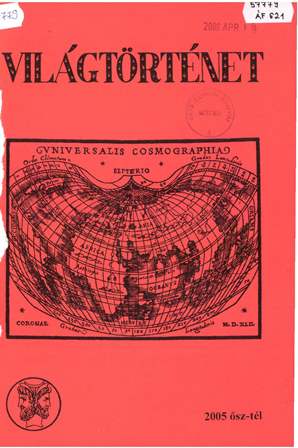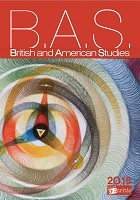
We kindly inform you that, as long as the subject affiliation of our 300.000+ articles is in progress, you might get unsufficient or no results on your third level or second level search. In this case, please broaden your search criteria.


Set in the context of the (inter)subjectivity research pursued in the general paradigm of cognitive science, and in Ronald Langacker’s theory of cognitive grammar in particular, the paper discusses the merits of cognitive theory in literary studies. Assuming, as cognitive linguists do, that meaning emerges from discourse as a result of the speaker-hearer meaning negotiation process, we claim that the cognitive paradigm can open new vistas in literary research, allowing for a joint linguistic and literary textual analysis to be carried out.
More...
Two basic categories of narrative theory are used to examine George Eliot’s 1859 novella: anachrony (retrospection and anticipation, but chiefly the latter) and focalization (especially the so-called “internal focalization”). The paper shows how these two devices work together to render the complexities of human psyche. Special emphasis is placed on the story’s meta-fictional dimension.
More...
This paper proposes a pragmatic and semantic study of the English knockknock jokes, paying particular attention to the dimension of reference, in general, and the use of proper names, in particular, which are described from the viewpoint of discourse analysis and psycholinguistics. The article aims at underlining the twofold discursive function (i.e., identifying and diverging) that names fulfil in this variety of humorous texts. In the end, the study also tries to show how this pattern of English jokes has recently been adapted to Romanian.
More...
The present paper focuses on how the Arabic expression ‘inshallah’ (i.e. “God willing”) is used in English by Arab speakers and how it is (mis)understood by non-Arab/non-Muslim speakers of English. I start from some general considerations pertaining to intercultural communication, and then proceed to examine how cultural differences can account for communication barriers and failures. The last part of my paper looks at the various communicative functions of ‘inshallah’ from a speech-act theoretic perspective.
More...
Distributional studies quantify the similarity of words by collecting word co-occurrence frequency information from large text corpora. According to the distributional hypothesis, this similarity is a semantic phenomenon. This paper aims to introduce the basics of Distributional Semantics and a new tool, spaceXplorer, which facilitates distributional investigations by collecting co-occurrence information from a Wikipedia snapshot (with or without using linguistic annotation) and displays word similarity information through a convenient, interactive user interface.
More...
One of the most widely known contemporary plays of today’s American theater, Tracy Letts’ “August: Osage County”(2007), is a literary and dramatic nexus that reunites a significant Western cultural heritage coming from authors such as Eugene O’Neill, Arthur Miller or Federico García Lorca. The paper follows the connections between Tracy Letts’ play and other remarkable dramas of Western theater, while also exploring its thematic structures and characters from a comparative perspective.
More...
Literary theory and criticism of several recent decades have been dominated by cultural studies situating literary works within wider contexts of social, ideological and ethnic struggles. This approach naturally ignores more traditional focus on universal aspects of literary works. The article attempts to illustrate a shift from the universally human to the culturally relativistic in literary studies through a discussion of the critical evaluation of Romanticism offered by some traditional and non-traditional critical approaches to the study of literature, especially deconstruction. The paper’s main objective is to argue, using the work of William Wordsworth, that literature is, first of all, a reflection of our common humanity, not of particular ideologies.
More...
Mary Shelley always showed a deep interest in the themes of reanimation and immortality, closely connected with her biographical experience and her political and social engagement. This paper aims at exploring this subject in her short stories, mainly focusing on “Valerius, the Reanimated Roman”, “The Mortal Immortal”, and “Roger Dodsworth: The Reanimated Englishman”.
More...
Starting from the idea of perception as it applies to literature, and taking into account the effect that reading can have over someone, I discuss the way in which perception of Gothic texts and monsters changes from dread and fear in the 18th century Gothic literature to love in today’s postmodern Gothic, as a consequence of the transformations that we have undergone, and that have resulted in radical shifts of mentality and an overt expression of everything that was once hidden, repressed and despairingly desirable, done through the use of words that leave no room for misinterpretation.
More...
With his political plays, Sir David Hare is one of the greatest names of the international drama. His most popular play of the Middle East is “Stuff Happens”, a theatrical reaction after 9/11. It turns around the ideas of some western political figures to explain the political scene initially in the U.S.A. before the invasion of Iraq. This work comes up with a new idea that the former US President, George W. Bush who is one of the significant characters of the play is a ‘charismatic leader’. The work tries to support that idea through some sociological views of Max Weber.
More...
According to the popular interpretations, Arthur Conan Doyle’s “The Sign of Four” (2004) can be read either as a story of revenge and reverse colonisation or of an exotic contamination of the British Empire. This paper combines these two approaches in order to emphasise the medial aspect of tropical invasion and its consequences to national constitution embodied by Sherlock Holmes.
More...
George MacDonald’s “Adela Cathcart” narrates the process of curing an ill young woman through storytelling. The individual stories subtly criticize the medical discourses and practices, social and gender roles and the spiritual and religious life of the era; Adela’s malady of “hysteria” is cured, eventually, by addressing and alleviating the sickness in the above fields. I compare and contrast diagnoses and cures of female maladies (both material and spiritual) prevalent in late Victorian medicine with those in the novel, demonstrating the extent to which MacDonald differed from his contemporaries and was, in fact, ahead of his time.
More...
The aim of this paper is to offer a simplified version of the NLP communication model which I will use to reveal more about how we communicate, generate ideas, make decisions and produce behaviour. I will first explain the mechanism of the model to give an overall understanding of how it works; then, I will analyze the implications of the relationship between communication and language which acts as a filter on the world.
More...
This article looks at Charlotte Brontë’s novel “Jane Eyre” in search of the embedded mechanisms that make changes regarding women’s role in society and their proper education emerge as logical necessities, even though, apparently, no character in this novel is a consequent supporter of change, not even Jane. Some characters advocate women’s education in order to better cope with the vicissitudes on a Christian moral level, while revealing themselves as abusers. Young Jane gets to depend on such people several times, and barely survives. Critics notice the distance between young Jane’s words, advocating the need for change, and mature Jane’s apparent abandonment of the cause for an idyllic domestic life. But the “autobiographic” formula points at different conclusions and those conclusions surpass what the characters have to say.
More...
This article takes issue with postmodern allegorical quests as theorized by, for example, Schiralli (1999), Caputo (1997) and Petrolle (2008). While alert to the deconstructive project, these critics wish to reconstruct (as opposed to deconstruct) the value of truth claims in the midst of ontological doubts. The aim is to rehabilitate truth/value claims, while utilising postmodernist deconstruction serving a reconstructive, even spiritual purpose. I shall illustrate this dynamic based on JM Coetzee’s most recent fiction.
More...
The paper examines Thomas Pynchon’s latest novel, “Bleeding Edge”, through the lens of points of convergence with and divergence from the writer’s earlier aesthetic practice and thematic scope, arguing that it represents the most direct expression of the post-postmodernist sensibility that has increasingly permeated his later fiction. More specifically, the essay discusses the ways in which the novel reflects the tension between a stylistic, residual postmodernism, and the emotional seriousness inherent in its treatment of such thematic concerns as the importance of communal bonds and the question of trust as an essential foundation for any form of commonality.
More...
The paper analyses the representation of women from a relatively unexplored point of view: that of metaphonology, namely how direct speech is introduced or described by the narrator, as it is actually interesting to see how women’s speech was rendered in an era when their silence was most cherished. Thackeray’s “Vanity Fair” offers good material to work on, as it presents two different kinds of woman: the submissive ‘womanly woman’, Amelia, and the outgoing ‘new woman’, Rebecca. I aim to discuss how female characters’ speech acts help to elucidate their role in the novel and their attitude towards society.
More...
Forms of knowledge regarding masculinity and femininity are socially constructed and discursively constituted. In this sense, cultural productions play an indispensible role in both representing and shaping masculinities. Making use of the insights provided by Deleuze and Guattari, this paper examines performatively constituted masculinities in Lord Byron’s “Turkish Tales”, with particular emphasis on the portrayal of male identity as fluid, metamorphic and capable of multiple possibilities. Representations of masculinity in Byron’s “Turkish Tales” clearly illustrates that masculinity is not a fixed/universal concept, but one that would be better understood in light of Deleuze and Guattari’s theory of becoming and may vary from one region to another.
More...
In a society based on prudery and repression of female sexuality, a prostitute reinforced the masculine dichotomised image of woman: Madonna/harlot. Prostitutes were liminal characters of subplots, until Gaskell’s Ruth. The unlucky destiny of an unwed mother, compelled to work as a dressmaker in slavery condition, was supposed to be disturbing enough to shake Victorian hypocrisy. The aim of my study is to analyze the novel as a contrasting counterpart of Victorian social beliefs and show the hermeneutic complexity of the protagonist who reacts by creating her own position in society without becoming a rebel.
More...